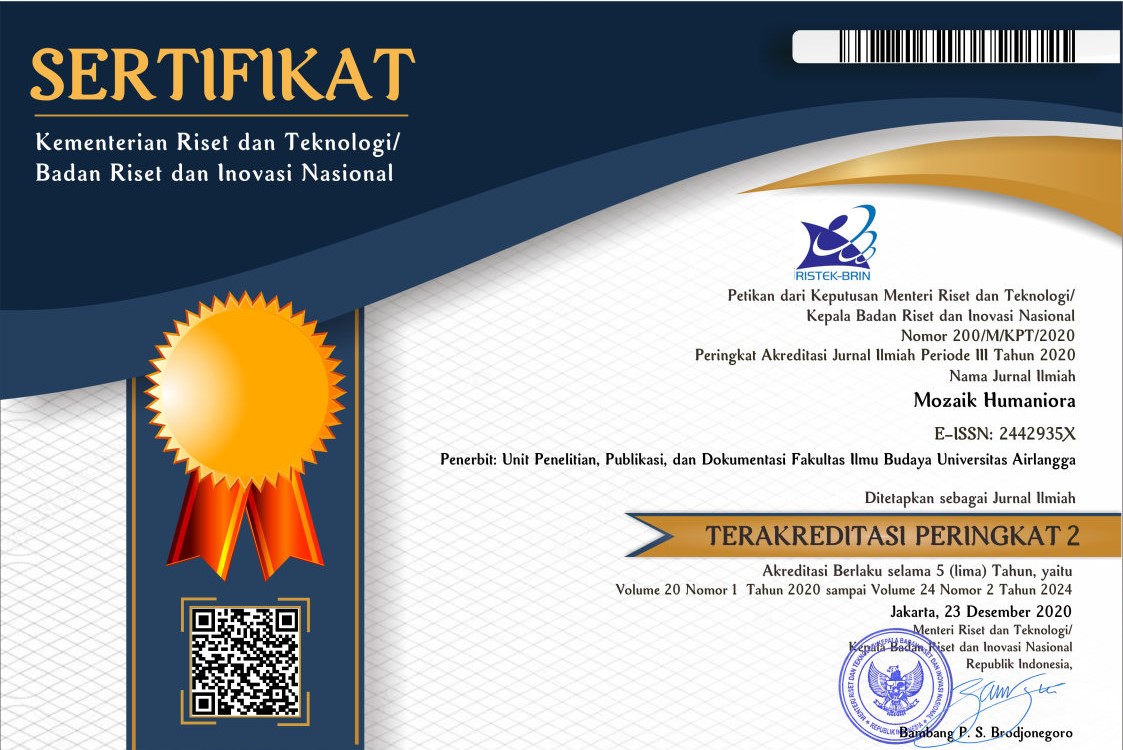Surviving Modernity Through Magic: A Participatory Study on Pekalongan Sintren Performance
Downloads
This study aims to analyze how magic is performed in Sintren and what survival strategies are applied by its performers in the modern era. Sintren is a unique folk art of Pekalongan performed by a regional arts group called Kudo Bekso Utomo from Pringsurat village, Kajen sub-district, Pekalongan on June 23rd, 2018 during the Syawalan festivals in Linggo Asri village, Pekalongan, Central Java, Indonesia. To achieve this goal, the researcher uses qualitative method. Data are collected by participatory observation and interview with the Sintren dancers, the Sintren shamans, and the Sintren audiences. Furthermore, the data are analyzed by the concept of performance by Goffman together with the concept of "magic” and "trick” by O'Connor. This study finds that Sintren folk art is a unique performance which is not a trick, but full of magic. Besides, this study also reveals that Kudo Bekso Utomo survives to maintain this traditional performance by applying economic strategies, such as using simpler costumes/performance tools, always conducting performance in every event whether formally invited or not, as well as trying to present non-virgin dancer. These strategies even can be adopted or adapted by other regional arts groups to cope modernity
Aditama, L. D. (2016). Kesenian Sintren sebagai Kearifan Lokal Ditinjau dari Metafisika Anton Bakker. Humaniora, 21(1), 57–72. Retrieved from https://media.neliti.com/media/publications/124437-ID-kesenian-sintren-sebagai-kearifan-lokald.pdf
Asdhiana, I. M. (2014). Gemulai Sintren di Pesisir Pekalongan. Retrieved January 31, 2019, from https://travel.kompas.com/read/2014/10/23/154000527
Ben-Amos, D. (1997). No Title. In T. A. Green (Ed.), Folklore: An Encyclopedia of Beliefs, Customs, Tales, Music, and Art. (pp. 630–634). Santa Barbara, California: ABC-CLIO, Inc.
Bro, G. (2016). Mencari Jejak Sintren, Kesenian Rakyat Asli Pekalongan Yang Telah Punah. Retrieved January 31, 2019, from https://www.pekalongan-news.com/2016/01/mencari-jejak-sintren-kesenian-rakyat.html
Bronner, S. J. (2007). The Meaning of Folklore: The Analytical Essays of Alan Dundes. Logan, Utah: Utah State University Press.
Dundes, A. (1965). The Study of Folklore. Upper Saddle River, NJ: Prentice Hall.
Goffman, E. (1956). The Representation of Self in Everyday Life. Edinburgh: The University of Edinburgh. Social Science Research Centre.
Jones, M. (n.d.). What is Trance? Retrieved November 11, 2018, from http://www.cuyamungueinstitute.com/articles-and-news/what-is-trance/
Kynth. (2007). shaman. Retrieved November 10, 2018, from https://www.urbandictionary.com/define.php?term=shaman
magic-trick. (n.d.). Retrieved November 11, 2018, from http://www.yourdictionary.com/magic-trick
Magic vs Trick - What's the difference? (n.d.). Retrieved November 10, 2018, from https://wikidiff.com/magic/trick
McCormick, C. (1997). Participant-Observation Method. In T. A. Green (Ed.), Folklore: An Encyclopedia of Beliefs, Customs, Tales, Music, and Art (pp. 628–629). Santa Barbara, California: ABC-CLIO, Inc.
O'Connor, K. M. (1997). Participant-Observation Method. In T. A. Green (Ed.), Folklore: An Encyclopedia of Beliefs, Customs, Tales, Music, and Art. (pp. 628–629). Santa Barbara, California: ABC-CLIO, Inc.
Pentikäinen, J. (1997). Shamanism. In T. A. Green (Ed.), Folklore: An Encyclopedia of Beliefs, Customs, Tales, Music, and Art (pp. 764–766). Santa Barbara, California: ABC-CLIO, Inc.
Ribkha, M. (n.d.). Kisah Asal-Usul Kesenian Sintren Pekalongan. Retrieved November 11, 2018, from https://www.cintapekalongan.com/kisah-asal-usul-kesenian-sintren-%0Apekalongan/%0A
Trick. (n.d.). Retrieved November 11, 2018, from https://www.google.com/search?source=hp&ei=IIjnW6OwKYrhvgTu6YC4%0ACQ&q=what+is+a+trick%3F&oq=what+is+a+trick%3F&gs_l=psy-%0Aab.3..0i19k1l10.2269.8161.0.8584.16.16.0.0.0.0.100.1233.15j1.16.0....0...1.1.%0A64.psy-ab..0.16.1225...0j0i131k1j0i22i30k1.0.XETKxQ

Mozaik Humaniora is licensed under a Creative Commons Attribution-ShareAlike 4.0 International License. Both authors and Mozaik Humaniora agree with the following attribution of journal:
1. Copyright of this journal is possession of Author, by the knowledge of the Editorial Board and Journal Manager, while the moral right of the publication belongs to the author.
2. The journal allows the author(s) to retain publishing rights without restrictions
3. The legal formal aspect of journal publication accessibility refers to Creative Commons Attribution Share-Alike (CC BY-SA).
4. The Creative Commons Attribution Share-Alike (CC BY-SA) license allows re-distribution and re-use of a licensed work on the conditions that the creator is appropriately credited and that any derivative work is made available under "the same, similar or a compatible license”. Other than the conditions mentioned above, the editorial board is not responsible for copyright violation.


















